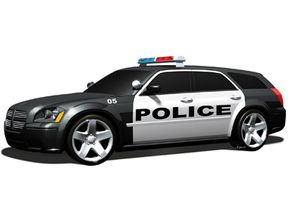Police Car Components
Take a moment to consider the kind of abuse a police car has to endure. At one extreme, it might be pushed to the very limits of its performance, chasing fleeing suspects at speeds greater than 100 mph (161 kilometers per hour). It might be driven over rough terrain, smashed into by angry criminals, or used as a battering ram by the officer behind the wheel.
At the other end of the spectrum, a police car could spend all day sitting in one place, idling for hour after hour or cruising along at low speeds as the officer waits for speeders or patrols a suburban neighborhood. A police car has to do this under relentless summer sun and in the depths of frigid winter nights, and it often has to switch from "idle" to "action" in a split second. While doing all this, the car needs to provide enough power for the radio systems, a computer, lights, sirens and any other equipment that might be installed on the car. As if all that weren't enough, police cars are heavy -- about 1,000 pounds (454 kilograms) heavier than their civilian counterparts, depending on the model and what options are installed. It's important to remember that the primary goal in designing the average police car is not power or performance, but durability.
Advertisement
To get the job done, a police car needs some heavy-duty components:
- High-performance engines - Police departments have to strike a balance between power and economy. While a few cars may be equipped with V8 engines for chases or highway work, the bulk of the patrol fleet will usually have V6 engines, which use less fuel. In either case, police cars require engines that can endure severe use.
- Upgraded alternator - The alternator takes energy from the running engine and coverts it into electricity to run lights, sirens and other electrical systems and equipment. Police cars use alternators that can crank out 225 amps or more. A typical civilian car's alternator generates less than 100 amps [source: American Power Systems, Inc.]. A heavy-duty battery also bolsters the electrical system.
- Coolers - Civilian cars mostly rely on their radiator to provide cooling, but the extreme conditions police cars are subjected to create the need for dedicated cooling systems through the vehicle. Transmission and oil coolers are standard equipment, along with a beefed-up radiator and a larger fan. Sometimes a power steering cooler might be included as well.
- Heavy duty suspension and brakes - The added weight of all the police options, along with the high performance maneuvers police cars are sometimes required to perform, require upgrades of the suspension and brakes. Larger, stronger brakes, heavier springs, shocks and stabilizer bars help police cars turn and stop smoothly despite their added bulk.
- Other heavy duty components - The drive shaft, u-joints, frame mounts, wheels and exhaust system are all sturdier than those in a civilian car [source: McCord].
In the next section, we'll find out what other special equipment is installed in a police car to help officers do their jobs.
